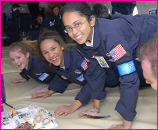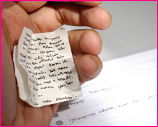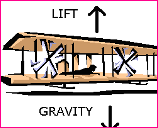Posted on March 31st, 2011 by Jaimie Schock
 Twelve students have won the National STEM Video Game Challenge, according to Education Week. They include a team of students who developed a game called, “You Make Me Sick!” to teach about bacteria and viruses. Inspired by the Educate to Innovate Campaign, President Obama’s initiative to promote a renewed focus on Science, Technology, Engineering, and Math (STEM) education, the contest aims to motivate interest in STEM learning among America’s youth by tapping into students’ natural passions for playing and making video games.
Twelve students have won the National STEM Video Game Challenge, according to Education Week. They include a team of students who developed a game called, “You Make Me Sick!” to teach about bacteria and viruses. Inspired by the Educate to Innovate Campaign, President Obama’s initiative to promote a renewed focus on Science, Technology, Engineering, and Math (STEM) education, the contest aims to motivate interest in STEM learning among America’s youth by tapping into students’ natural passions for playing and making video games.
Read More
Filed under: Grades 6-8, Grades K-5, K-12 Outreach Programs | Comments Off on STEM Video Game Challenge Names Winners
Tags: Competition, Competitions for Students, Computer Engineering, Computer Programming, Computer Science, Contest, Contests, Science Contest, Software, Videos
Posted on March 30th, 2011 by Jaimie Schock
 The AFCEA Educational Foundation is offering 50 scholarships of $5,000 each to students actively pursuing an undergraduate degree, graduate degree, or credential/licensure for the purpose of teaching STEM (science, technology, engineering, or math) subjects at a U.S. middle or secondary school. Application Deadline: May 1, 2011.
The AFCEA Educational Foundation is offering 50 scholarships of $5,000 each to students actively pursuing an undergraduate degree, graduate degree, or credential/licensure for the purpose of teaching STEM (science, technology, engineering, or math) subjects at a U.S. middle or secondary school. Application Deadline: May 1, 2011.
Read More
Filed under: For Teachers, K-12 Outreach Programs | Comments Off on STEM Teachers’ Scholarships
Tags: Higher Education, Programs for Teachers, Scholarship, scholarships, Scholarships and Fellowships, Teachers
Posted on March 28th, 2011 by Jaimie Schock
 The children’s programming TV network Nickelodeon is offering to feature camera footage of events with groups performing “green activities” that promote a healthy Earth environment. Submitted footage may be featured on the network or on their website.
The children’s programming TV network Nickelodeon is offering to feature camera footage of events with groups performing “green activities” that promote a healthy Earth environment. Submitted footage may be featured on the network or on their website.
Read More
Filed under: Web Resources | Comments Off on Nickelodeon: Earth Day Events Promotion
Tags: Environmental Engineering, Environmental science, Events, Green, Outreach, Television, Video contest
Posted on March 27th, 2011 by ASEE
 Many kids dream of exploring space, but few get much further than their schoolyards. This is not true of students in Tekna-Theos, a Florida after-school program bursting with science activities and contests. They’ve set their sights high, designing and building mini-satellites and preparing a payload to test the effect of weightlessness on bone cells. Some have actually experienced “Zero-G.”
Many kids dream of exploring space, but few get much further than their schoolyards. This is not true of students in Tekna-Theos, a Florida after-school program bursting with science activities and contests. They’ve set their sights high, designing and building mini-satellites and preparing a payload to test the effect of weightlessness on bone cells. Some have actually experienced “Zero-G.”
Read More
Filed under: Special Features | 3 Comments »
Tags: Aeronautics, Aerospace, Aerospace Engineering, Biomolecular Engineering, CubeSat, NASA, Satellite, Satellite imagery, Satellites, Space, Teachers
Posted on March 27th, 2011 by ASEE
 In this lesson, you’ll introduce your students to the four forces of flight–drag, lift, thrust, and weight–through a variety of fun-filled flight experiments. Students will “fly” for short periods and then evaluate factors that might either increase or decrease their “flight” duration.
In this lesson, you’ll introduce your students to the four forces of flight–drag, lift, thrust, and weight–through a variety of fun-filled flight experiments. Students will “fly” for short periods and then evaluate factors that might either increase or decrease their “flight” duration.
Read More
Filed under: Class Activities, Grades 6-8, Grades 6-8, Grades K-5, Grades K-5, Lesson Plans | 1 Comment »
Tags: Aerodynamics, Aeronautics, Class Activities, Lesson Plan, Physics
Posted on March 27th, 2011 by Mary Lord
 It’s easy to find your way to school. Now imagine trying to navigate the skies, with no signs to point you in the right direction. How do pilots find their way? These “pilot training lessons” developed by the Center for Innovation in Engineering and Science Education at the Stevens Institute of Technology will teach your young aviators the principles of navigation in a fun series of real-time activities.
It’s easy to find your way to school. Now imagine trying to navigate the skies, with no signs to point you in the right direction. How do pilots find their way? These “pilot training lessons” developed by the Center for Innovation in Engineering and Science Education at the Stevens Institute of Technology will teach your young aviators the principles of navigation in a fun series of real-time activities.
Read More
Filed under: Class Activities, Grades 6-8, Grades 6-8, Grades 9-12, Grades K-5, Lesson Plans, Web Resources | 2 Comments »
Tags: Aeronautics, Aerospace, airplane, Class Activities, flight, Grades 6-8, Lesson Plan, Mathematics, NASA, Physics, vectors, windspeed
Posted on March 27th, 2011 by Mary Lord
 The number of U.S. schools with such poor graduation rates that they are known as “dropout factories” fell by 6.4 percent between 2008 and 2009, according to a report released at the Building a Grad Nation Summit in Washington, D.C., March 22. The report also included recommendations to help ensure a high school graduation rate of 90 percent for the class of 2020–today’s third graders.
The number of U.S. schools with such poor graduation rates that they are known as “dropout factories” fell by 6.4 percent between 2008 and 2009, according to a report released at the Building a Grad Nation Summit in Washington, D.C., March 22. The report also included recommendations to help ensure a high school graduation rate of 90 percent for the class of 2020–today’s third graders.
Read More
Filed under: K-12 Education News | Comments Off on Dropout Factories Decline
Tags: Education Policy, Outreach for Schools, Public Policy, Research on Learning
Posted on March 27th, 2011 by ASEE
 In response to cheating, many states and school districts are tightening test security, USA Today reports. Texas distributes 14 steps staff must follow during test administration and warns that state investigators will ferret out cheaters. In other places, educators are experimenting with different ways to test what kids learn.
In response to cheating, many states and school districts are tightening test security, USA Today reports. Texas distributes 14 steps staff must follow during test administration and warns that state investigators will ferret out cheaters. In other places, educators are experimenting with different ways to test what kids learn.
Read More
Filed under: K-12 Education News | Comments Off on States Crack Down on Test Tampering
Tags: Education Policy, Public Policy, Teachers, Testing
Posted on March 25th, 2011 by Mary Lord
 In this lesson, you’ll introduce your students to the four forces of flight — drag, lift, thrust, and weight — through a variety of fun flight experiments. Students will “fly” for short periods and then evaluate factors that might either increase or decrease their “flight” duration. They also will discover how air moving at different speeds over a wing keeps planes aloft.
In this lesson, you’ll introduce your students to the four forces of flight — drag, lift, thrust, and weight — through a variety of fun flight experiments. Students will “fly” for short periods and then evaluate factors that might either increase or decrease their “flight” duration. They also will discover how air moving at different speeds over a wing keeps planes aloft.
Read More
Filed under: Grades 6-8, Grades 9-12, Lesson Plans | 1 Comment »
Tags: Aerodynamics, Aeronautics, Aerospace, Lesson Plan, Lesson Plans
 Twelve students have won the National STEM Video Game Challenge, according to Education Week. They include a team of students who developed a game called, “You Make Me Sick!” to teach about bacteria and viruses. Inspired by the Educate to Innovate Campaign, President Obama’s initiative to promote a renewed focus on Science, Technology, Engineering, and Math (STEM) education, the contest aims to motivate interest in STEM learning among America’s youth by tapping into students’ natural passions for playing and making video games.
Twelve students have won the National STEM Video Game Challenge, according to Education Week. They include a team of students who developed a game called, “You Make Me Sick!” to teach about bacteria and viruses. Inspired by the Educate to Innovate Campaign, President Obama’s initiative to promote a renewed focus on Science, Technology, Engineering, and Math (STEM) education, the contest aims to motivate interest in STEM learning among America’s youth by tapping into students’ natural passions for playing and making video games.








 The AFCEA Educational Foundation is offering 50 scholarships of $5,000 each to students actively pursuing an undergraduate degree, graduate degree, or credential/licensure for the purpose of teaching STEM (science, technology, engineering, or math) subjects at a U.S. middle or secondary school. Application Deadline: May 1, 2011.
The AFCEA Educational Foundation is offering 50 scholarships of $5,000 each to students actively pursuing an undergraduate degree, graduate degree, or credential/licensure for the purpose of teaching STEM (science, technology, engineering, or math) subjects at a U.S. middle or secondary school. Application Deadline: May 1, 2011.  The children’s programming TV network Nickelodeon is offering to feature camera footage of events with groups performing “green activities” that promote a healthy Earth environment. Submitted footage may be featured on the network or on their website.
The children’s programming TV network Nickelodeon is offering to feature camera footage of events with groups performing “green activities” that promote a healthy Earth environment. Submitted footage may be featured on the network or on their website. Many kids dream of exploring space, but few get much further than their schoolyards. This is not true of students in Tekna-Theos, a Florida after-school program bursting with science activities and contests. They’ve set their sights high, designing and building mini-satellites and preparing a payload to test the effect of weightlessness on bone cells. Some have actually experienced “Zero-G.”
Many kids dream of exploring space, but few get much further than their schoolyards. This is not true of students in Tekna-Theos, a Florida after-school program bursting with science activities and contests. They’ve set their sights high, designing and building mini-satellites and preparing a payload to test the effect of weightlessness on bone cells. Some have actually experienced “Zero-G.” In this lesson, you’ll introduce your students to the four forces of flight–drag, lift, thrust, and weight–through a variety of fun-filled flight experiments. Students will “fly” for short periods and then evaluate factors that might either increase or decrease their “flight” duration.
In this lesson, you’ll introduce your students to the four forces of flight–drag, lift, thrust, and weight–through a variety of fun-filled flight experiments. Students will “fly” for short periods and then evaluate factors that might either increase or decrease their “flight” duration. It’s easy to find your way to school. Now imagine trying to navigate the skies, with no signs to point you in the right direction. How do pilots find their way? These “pilot training lessons” developed by the Center for Innovation in Engineering and Science Education at the Stevens Institute of Technology will teach your young aviators the principles of navigation in a fun series of real-time activities.
It’s easy to find your way to school. Now imagine trying to navigate the skies, with no signs to point you in the right direction. How do pilots find their way? These “pilot training lessons” developed by the Center for Innovation in Engineering and Science Education at the Stevens Institute of Technology will teach your young aviators the principles of navigation in a fun series of real-time activities. The number of U.S. schools with such poor graduation rates that they are known as “dropout factories” fell by 6.4 percent between 2008 and 2009, according to a report released at the Building a Grad Nation Summit in Washington, D.C., March 22. The report also included recommendations to help ensure a high school graduation rate of 90 percent for the class of 2020–today’s third graders.
The number of U.S. schools with such poor graduation rates that they are known as “dropout factories” fell by 6.4 percent between 2008 and 2009, according to a report released at the Building a Grad Nation Summit in Washington, D.C., March 22. The report also included recommendations to help ensure a high school graduation rate of 90 percent for the class of 2020–today’s third graders.  In response to cheating, many states and school districts are tightening test security, USA Today reports. Texas distributes 14 steps staff must follow during test administration and warns that state investigators will ferret out cheaters. In other places, educators are experimenting with different ways to test what kids learn.
In response to cheating, many states and school districts are tightening test security, USA Today reports. Texas distributes 14 steps staff must follow during test administration and warns that state investigators will ferret out cheaters. In other places, educators are experimenting with different ways to test what kids learn.  In this lesson, you’ll introduce your students to the four forces of flight — drag, lift, thrust, and weight — through a variety of fun flight experiments. Students will “fly” for short periods and then evaluate factors that might either increase or decrease their “flight” duration. They also will discover how air moving at different speeds over a wing keeps planes aloft.
In this lesson, you’ll introduce your students to the four forces of flight — drag, lift, thrust, and weight — through a variety of fun flight experiments. Students will “fly” for short periods and then evaluate factors that might either increase or decrease their “flight” duration. They also will discover how air moving at different speeds over a wing keeps planes aloft.